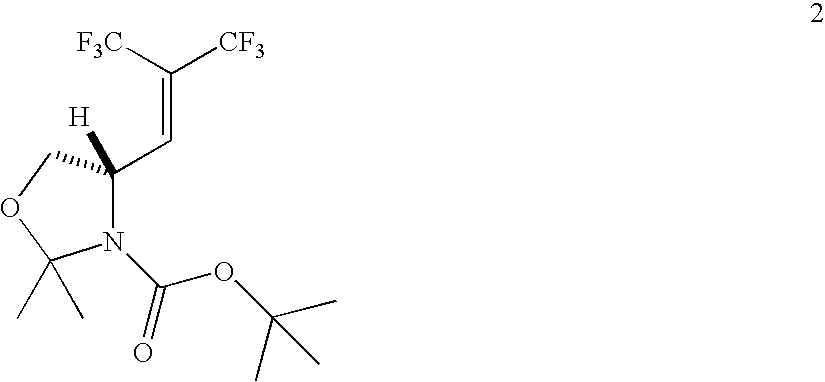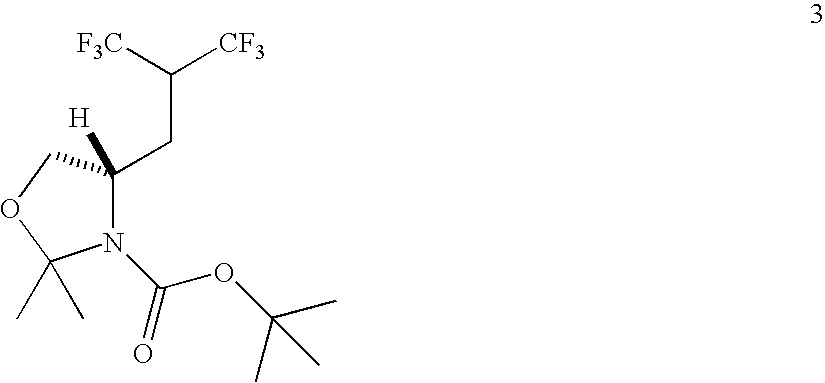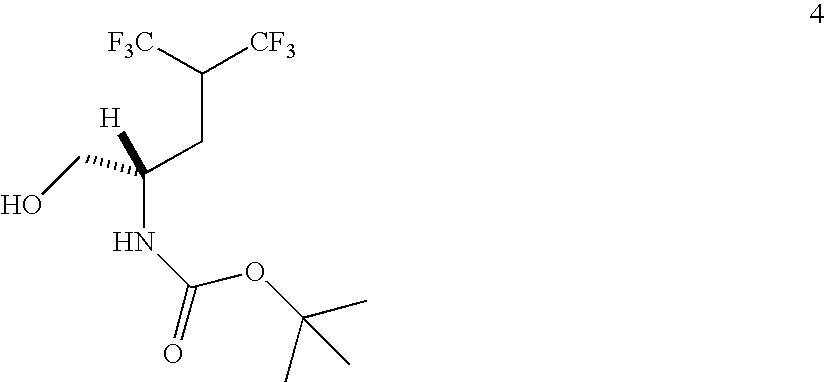Proteins Containing a Fluorinated Amino Acid, and Methods of Using Same
a technology of fluorinated amino acids and proteins, which is applied in the field of proteins containing fluorinated amino acids, can solve the problems of serious hampered clinical utility of native glp-1 and serious threat to human health, and achieve the effects of increasing the protease resistance of biologically active peptides, enhancing thermal and chemical stability, and enhancing potency
- Summary
- Abstract
- Description
- Claims
- Application Information
AI Technical Summary
Benefits of technology
Problems solved by technology
Method used
Image
Examples
example 1
Synthesis of Bis-trifluoromethyl olefin (2)
[0222]
[0223]Typical procedure for the coupling reaction: To a stirred solution of the Garner aldehyde 1 (7.0 g, 31.0 mmol) and PPh3 (57 g, 217 mmol) in dry Et2O (300 mL) was added 2,2,4,4-tetrakis-(trifluoromethyl)-1,3-dithietane (39.5 g, 108.5 mmol) at −78° C. under argon. The mixture was stirred for 3 d while being slowly warmed to room temperature. The reaction slowly accumulated an insoluble white solid which was filtered and the filtrate concentrated. The residue was further dissolved in n-pentane (300 mL) and filtered again to remove insoluble impurities. After removal of the solvent, the residue was subjected to flash column chromatography using n-pentane / Et2O (6 / 1) as eluant to give pure 2 as a pale yellow oil (10.4 g, 92%). 1H NMR (300 MHz, CDCl3) δ 6.70 (d, 1H, J=8.7 Hz), 4.81 (bs, 1H), 4.23 (dd, 1H, J=6.9 Hz, 9.3 Hz), 3.79 (dd, 1H, J=3.9 Hz, 9.3 Hz), 1.65 (s, 3H), 1.56 (s, 3H), 1.42 (s, 9H); 19F NMR (282.6 MHz, CDCl3 / CFCl3) δ−65....
example 2
Synthesis of Oxazolidine (3)
[0224]
[0225]A 500 mL round bottomed flask was charged with a solution of 2 (10.3 g, 28.3 mmol) in THF (250 mL) and 10% Pd / C (40 g). The reaction flask was purged with argon and hydrogen sequentially and stirred under hydrogen at room temperature until uptake of H2 ceased (24 hours). The catalyst was then separated from the reaction mixture by filtration (and can be used again). The filtrate was dried over anhydrous MgSO4 and concentrated by rotary evaporation to give 3 (10.1 g, 98% yield) as a pale yellow oil. 1H NMR (300 MH, CDCl3) δ 4.23 (4.05) (m, 1H), 4.00 (dd, 1H, J=5.4 Hz, 9.3 Hz), 3.73 (d, 1H, J=9.3 Hz), 3.58 (3.05) (m, 1H), 2.18 (2.01) (m, 2H), 1.62 (1.58) (s, 3H), 1.48 (br. s, 12H); 13C NMR (75.5 MHz, CDCl3) δ 153.22 (151.51) (C═O), 123.89 (q, 2×CF3, 1JCF=284.0), 94.47 (94.03) (C), 80.85 (80.73) (C), 67.26 (66.65) (CH2), 55.58 (55.12) (CH), 45.44 (45.12) (quintet, CH, 2JCF=27.2 Hz), 28.98 (28.00) (CH2), 28.25 (3×CH3), 27.58 (26.90) (CH3), 24.15 (...
example 3
Synthesis of N-Boc-5,5,5,5′,5′,5′-(S)-Hexafluoroleucinol (4)
[0226]
[0227]To a solution of 3 (10.1 g, 27.6 mmol) in CH2Cl2 (30 mL) was added 10 mL of trifluoroacetic acid (TFA). The reaction mixture was stirred at room temperature for 5 min. After removal of the solvent and TFA, the residue was partitioned between 150 mL of ethyl ether and 100 mL of H2O. The organic layer was washed with water (20 mL×4), dried over MgSO4, and concentrated to give 4 (7.2 g, 80% yield) as a white solid. The aqueous layers contain a completely deprotected product due to cleavage of the BOC moiety as evidenced by ninhydrin active material. This hexafluoroamino alcohol can be converted back to 4 by protecting the free amine group as a BOC amide. 1H NMR (300 MHz, CDCl3) δ5.03 (d, 1H, J=8.1 Hz), 3.84 (m, 1H), 3.70 (m, 2H), 3.20 (m, 1H), 3.10 (br. s, 1H), 1.98 (m, 2H), 1.45 (s, 9H); 13C NMR (75.5 MHz, CDCl3) δ 156.57 (C═O), 124.00 (q, 2×CF3, 1JCF=284.0 Hz), 80.58 (C), 66.08 (CH2), 50.57 (CH), 45.09 (m, CH, 2J...
PUM
| Property | Measurement | Unit |
|---|---|---|
| half-life time | aaaaa | aaaaa |
| pH | aaaaa | aaaaa |
| pH | aaaaa | aaaaa |
Abstract
Description
Claims
Application Information
 Login to View More
Login to View More - R&D
- Intellectual Property
- Life Sciences
- Materials
- Tech Scout
- Unparalleled Data Quality
- Higher Quality Content
- 60% Fewer Hallucinations
Browse by: Latest US Patents, China's latest patents, Technical Efficacy Thesaurus, Application Domain, Technology Topic, Popular Technical Reports.
© 2025 PatSnap. All rights reserved.Legal|Privacy policy|Modern Slavery Act Transparency Statement|Sitemap|About US| Contact US: help@patsnap.com



